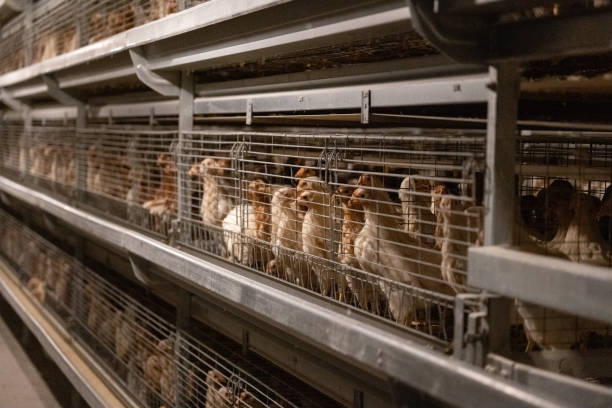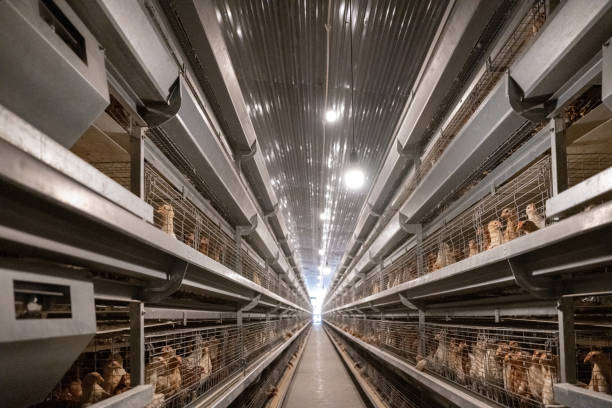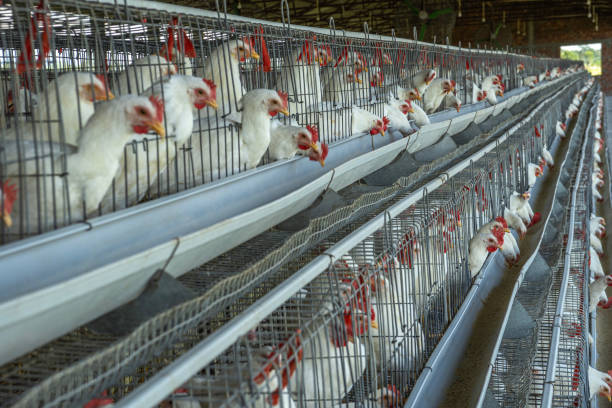
Step-by-Step Chicken Farm Setup Guide by Livi
Step-by-Step Chicken Farm Setup Guide by Livi
Starting a chicken farm can be one of the smartest moves you make in agriculture—whether you’re looking to raise broilers for meat or layers for eggs. But jumping in without a solid plan? That’s a fast track to frustration. At Livi Machinery, we’ve helped hundreds of farmers across Asia, Africa, and Latin America set up profitable chicken farms from scratch. And over the years, we’ve found something: success doesn’t come from luck—it comes from planning.
In this guide, we’ll walk you through every stage of setting up your chicken farm, from choosing your niche to installing automatic feeding systems. No fluff. Just practical, field-tested steps that work. Whether you’re new to poultry farming or expanding your current operation, this step-by-step setup guide will give you clarity, confidence, and a clear path forward.
Selecting Your Poultry Type & Business Model

First things first: are you raising laying hens or meat birds? This decision shapes everything—from your housing system to feed strategy. Let’s break it down.
If you’re aiming for steady income, egg production might be your best bet. Hens start laying around 18–20 weeks and can produce up to 300 eggs per year if managed well. Egg farming works great for semi-automatic or fully automated setups, especially with modern layer cage systems from Livi that boost productivity and reduce labor costs.
On the other hand, broiler farming is all about speed and turnover. You raise birds for 5–6 weeks and sell them for meat. It’s faster but also riskier—because any delay or disease outbreak hits hard. Still, demand for chicken meat keeps rising globally, making it a solid option for those who can manage tight biosecurity and efficient feeding practices.
Also, ask yourself: are you going commercial or backyard scale? A small 500-bird flock might suit a family-based operation with manual feeding. But if you want real profit, aim higher. We recommend starting with at least 2,000 birds using automated systems like our nipple drinkers and chain feeders. Automation isn’t luxury anymore—it’s what keeps your margins healthy as labor and feed prices climb.
Site Selection & Poultry House Design
Location matters more than most beginners think. Pick a spot with good road access so you can easily bring in feed and take out eggs or birds. Stay away from residential zones—neighbors won’t appreciate the smell or noise. Instead, choose land on slightly elevated ground to avoid flooding during rains.
Once you’ve got the location, design your poultry house right. For optimal airflow and temperature control, orient the building east-west—this reduces direct sun exposure during hot afternoons. Length-to-width ratio should be around 4:1. Too wide, and ventilation becomes uneven; too narrow, and space gets wasted.
Now let’s talk materials. In colder regions, insulated walls and curtains help maintain warmth. In tropical areas, prioritize natural ventilation with open sides and cooling pads. Either way, ensure the floor is concrete—easy to clean, rodent-proof, and durable. Avoid soil floors—they trap moisture and harbor pathogens.
One thing many overlook: headroom. Keep ceiling height between 2.5 to 3 meters. Higher ceilings improve air circulation and let heat rise, keeping birds cooler in summer. Also, include eaves extending 0.6–0.8 meters around the structure to protect walls from rain splash and give shade near exits.
Here’s where Livi’s expertise shines—we don’t just sell cages; we help design entire houses tailored to climate, capacity, and automation level. Our team can send layout plans based on your land size and budget, ensuring everything fits perfectly before construction starts.
Choosing & Installing Modern Poultry Equipment
This is where the magic happens. Even the best location and house design won’t deliver results without proper equipment. Skip quality gear now, and you’ll pay later in labor, losses, and low performance.
Start with cages—but not just any cages. Go for galvanized steel layer cages or broiler batteries that resist rust and last over 10 years. They should have proper slope for egg rolling, mesh sizes suited to bird age, and easy-wash waste trays. At Livi, our multi-tier systems maximize space usage while reducing footprint—ideal for small farms aiming for big output.
Next, automate your core processes. Manual feeding wastes time and often leads to inconsistent portions. With an automatic chain feeder system, each bird eats evenly, grows uniformly, and reaches target weight faster. Same goes for watering—nipple drinkers prevent spillage, minimize wet litter, and cut disease risk dramatically. Dripping trays under drink lines? That’s outdated. Nipples + pressure regulators are the standard now.
Don’t forget manure removal. Accumulated droppings create ammonia, which harms bird health and lowers egg production. Belt scrapers or auger systems remove waste daily with minimal labor. Pair this with tunnel ventilation fans and cooling pads, and you’ve built a climate-controlled environment even in high heat.
And yes—add lighting control. Chickens respond strongly to light cycles. For layers, 14–16 hours of light per day boosts egg laying. Use LED controllers with timers to simulate dawn and dusk gradually. Stress-free birds = better productivity.
Livi offers full turnkey installations—from loading the truck to training your staff on how to operate each system. We even provide bilingual manuals and video tutorials so no detail gets lost in translation.
Final Steps: Stocking Birds & Ongoing Management
You’ve picked your model, built the house, installed top-grade gear—now it’s time to bring in the chicks. But go slow. Start with a trial batch, maybe 500–1,000 birds, to test your setup before scaling up. Source day-old chicks from reputable hatcheries with vaccination records. Healthy chicks should be alert, with dry feathers and strong legs.
Before they arrive, preheat the house at least 24 hours ahead. Target 32–35°C for broilers and 28–30°C for layers. Spread paper on the floor, sprinkle feed on it—this helps chicks find food fast. Place waterers close by and check frequently that all nipples are working. First 72 hours are critical. Most losses happen here due to cold stress or starvation.
Once settled, stick to a routine. Check feed levels twice daily. Clean water lines weekly. Monitor temperatures hourly during extreme weather. Vaccinate on schedule—usually ND, IB, Gumboro—and keep detailed logs. If something feels off (less movement, dull eyes), pull samples fast and consult a vet. Delay kills profits.
Most importantly, track your numbers: feed conversion ratio (FCR), mortality rate, average daily gain, egg production percentage. These metrics tell you what’s working—and what needs fixing. Use them to adjust stocking density, tweak ventilation, or change feed suppliers. Farming isn’t guesswork; it’s data-driven precision.
At Livi, we offer free advisory support for customers. Just send us your KPIs, and we’ll review them remotely, spotting trends and offering improvements. Some farms boosted profits by 20% just by adjusting feeder height and cleaning frequency.
Ready to Build Your High-Efficiency Chicken Farm?
We’ve taken you from idea to execution—choosing your model, designing the perfect house, installing smart equipment, and managing daily operations. The truth is, anyone can raise chickens. But only those with the right tools and knowledge build sustainable, profitable farms.
If you’re serious about getting started—or upgrading your current setup—we’d love to help. Share your project size, location, and goals with us, and we’ll send a customized proposal including layout sketches, equipment list, and budget estimate—all free. No obligation. Just real solutions from a team that’s been doing this since 2012.
Click below or leave your email and phone number. One of our poultry experts will reach out within 24 hours to answer questions and guide your next steps.
Frequently Asked Questions
What’s better: cage farming or free-range?
Cage systems offer higher biosecurity, lower labor, and better disease control. Free-range scores points in marketing (“natural eggs”), but requires more land, labor, and carries higher disease risk. For efficiency and scalability, caged systems win.
How many chickens can I raise per square meter?
It depends on type and age. For adult layers in tiered cages: 9–12 birds/m². Broilers on floor: 8–10 birds/m². Overcrowding causes stress and poor growth, so always follow breed-specific guidelines.

Do I need electricity for automatic systems?
Yes. Most automations—feeders, drinkers, fans, egg belts—run on electricity. Solar backup options are available for off-grid farms. We can design hybrid power setups upon request.
Can Livi help me source chicks and feed?
We focus on equipment and farm design. However, we partner with trusted suppliers and can refer reliable hatcheries and feed manufacturers based on your region.
How long does it take to install a full poultry system?
From delivery to completion: 1 to 2 weeks for small farms (5,000 birds). Larger projects (50,000+) take 3–4 weeks. We offer installation teams who travel overseas when needed.
Is training provided for operating the equipment?
Absolutely. All our clients get hands-on training—from basic maintenance to troubleshooting sensors and controllers. We also provide digital guides in multiple languages.
What warranty do Livi machines have?
Our steel cages and frames come with a 5-year rust-through warranty. Motors, rollers, and electrical parts are covered for 1 year. Most components last 10+ years with basic care.
How soon can I expect ROI on my farm investment?
Typically 8 to 14 months, depending on local prices, flock size, and automation level. Farms using Livi’s full systems report 30% lower labor cost and 15% better feed efficiency.
Can I expand my farm later with the same equipment?
Yes—our modular designs allow future expansion. Add more cages, extend feeding lines, or upgrade controls without replacing the whole system.
How do I contact Livi for a consultation?
Simply send your farm details—location, planned capacity, and goals—to [email protected] or use the contact form at www.livimachinery.com. Our team responds within one business day.
